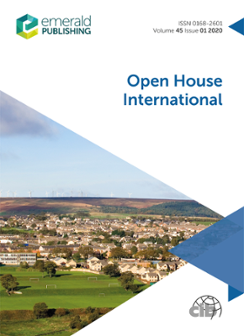Open House International
Issue(s) available: 76 – From Volume: 30 Issue: 1, to Volume: 49 Issue: 1

“YouWalk-UOS” – technology-enabled and user-centred assessment of urban open spaces
Ashraf M. Salama, Madhavi P. PatilThis paper introduces the YouWalk-UOS mobile application, a tool that revolutionises the assessment of urban open spaces (UOS). The paper demonstrates how integrating real-time…
Labor camps in Dubai: implications of courtyard regulations on daylight performance
Wael Sheta, Mariam El Hussainy, Sahar AbdelwahabThe fundamental aim of the study is to investigate the implications of labor housing designs in Dubai, with a focus on courtyards and the governing building regulations, on…
A systematic review of factors influencing self-governed public open spaces: insights from social-ecological system framework and collective action
Xuerui Shi, Gabriel Hoh Teck LingDue to the influence of complex and intersecting factors, self-governed public open spaces (POSs) (managed by local communities) are subject to collective action dilemmas such as…
Examination of spatial efficiency in super-tall towers within the Middle Eastern context
Hüseyin Emre IlgınSuper-tall towers have surfaced as a pragmatic remedy to meet the escalating requisites for both residential and commercial areas and to stimulate economic growth in the Middle…
Perceived neighborhood walkable environment, neighborhood interaction and mental health among residents of different age groups: a case study in Shanghai, China
Ning Sun, Yuhan Peng, Yingchen Lu, Wanting Liu, Zhenhua ZhengThis study aims to investigate the relationships between the perceived neighborhood walkable environment (PNWE), neighborhood interaction (NI) and residents’ mental health, with…
Trans-functional green wall’s developed predesign model as a first stage to designers to understand the design and potential performance aspects of green walls
Tamer Refaat, Marwa El-ZoklahThis study aims to formulate a user-friendly pre-design model that could be a decision support tool for green wall systems to assist designers in selecting an optimal green wall…
Applying the third-place concept for transitional spaces in the Korean university using the design charrette approach
Sabeen Mehmood Durrani, Suk-Kyung Kim, Holly MadillThis research investigates the impact of the COVID-19 pandemic on the use of transitional spaces in a Korean academic setting, to assess the impact of the pandemic on users'…
Where is the basic community infrastructure? Seeking for rural community transformation through community infrastructure planning in Sarawak, Malaysia
Mark Edward Tuah, Peter Aning Tedong, Melasutra Md DaliThis study investigated the role of community infrastructure planning in Sarawak, Malaysia, by concentrating on the obstacles that hinder effective governance of community…
Analysis of earthquake resilience factors for buildings: the case of Istanbul high-rise buildings
Zeynep Yeşim İlerisoy, Berru İzel GökgözThe objective of this study is to investigate the concept of “earthquake resistance” in high-rise buildings and assess the current level of structural strength in the areas where…
Public participation in the social sustainability evaluation of smart city infrastructure in the context of big data: a critical review
Hongyang Li, Anjie Xue, Junwei Zheng, Martin Skitmore, Matthew MoorheadThe current booming development of smart cities poses new requirements and challenges for their internal infrastructure development. This article aims to explore the questions…
Modeling the construction readiness parameters for abandoned housing projects in Malaysia: PLS-SEM approach
N. Aishah Abdul-Rahman, Rahimi A. Rahman, Ahmad Rizal AliasThis study aims to develop an interrelation model between critical parameters for assessing the construction readiness (CR) of abandoned housing projects, using Malaysia as a case…
Urban planning education in the global south: exploring the possibilities for Egyptian curricula
Ola Ahmed Maged, Robert Brown, Nancy Abdel-MoneimThe purpose of the research is to propose reforms that would help to bridge the gap between theory and practice and produce more effective urban planners. The research on urban…
Design strategies for circularity: Km0 architecture in the Spanish Mediterranean
Débora Domingo-Calabuig, Javier Rivera-Linares, Laura Lizondo-Sevilla, José Luis Alapont-RamónCity planning and construction have embraced circular economy principles, converting them into various indicators. Particularly in the European context, the question “what…
Exploring a comprehensive evaluation model for measuring spatial equity in the layout of city community elderly service facilities: a case study in Xi’an, China
Peiyu Wang, Qian Zhang, Zhimin Li, Fang Wang, Ying ShiThe study aims to devise a comprehensive evaluation model (CEM) for evaluating spatial equity in the layout of elderly service facilities (ESFs) to address the inequity in the…
Prioritizing user preferences for quasi – Public space by using analytic hierarchy process (AHP): bursa Podyum park, Turkey case
Nazli Deniz Ersoz, Sara Demir, Merve Dilman Gokkaya, Onur AksoyThis study aims to fill the lack of quantitative studies of user preferences in quasi-public spaces to observe the use of quasi-public spaces by questioning the contemporary needs…
Geometric analysis of early Ottoman tombs within the context of conservation studies
Zeynep Fatma Niğdeli, Funda Gençer, İzzet YüksekThe purpose of the study is to provide a dataset about geometrical constructions of early Ottoman tombs for conservation studies. Thus, a proposal for the restitution phase of the…
Teaching parametric design: fostering algorithmic thinking through incomplete recipes
Elena VazquezAlgorithmic and computational thinking are necessary skills for designers in an increasingly digital world. Parametric design, a method to construct designs based on algorithmic…
The case study methodology in architectural research: evaluation of epistemological adequacy
Amos KaluaThis study sought to populate a concise set of guidelines for use of the case study research methodology and evaluate the adequacy with which the methodology has been used…
Spatial accessibility dynamics of urban parks in Nanjing, China: implications for spatial equity
Zhe Liu, Weibo Liu, Bin ZhaoThis study aimed to explore the spatial accessibility dynamics of urban parks and their driving forces from 1901 to 2010 in terms of the dynamic relationships between spatial…
Kuwait's circular prototype mosque design: a history and comprehensive evaluation
Mohammed N. Alajmi, Yousef Al-Haroun, Rua Alshaheen, Mohammed Al-NafisiThis study evaluates the architectural status of circular prototype mosques in Kuwait. The argument is that the once dominant and powerful image of mosques is now merely a…
Development of a parametric optimization concept for the sun control of the outdoor spaces: the case study of 5A business park, Cairo, Egypt
Ayatallah Magdy, Ayman Hassaan Mahmoud, Ahmed SalehComfortable outdoor workspaces are important for employees in business parks and urban areas. Prioritizing a pleasant thermal environment is essential for employee productivity…
Crowding between urban planning and environmental psychology: guidelines for bridging the gap
Mai Hossam El-Didy, Ghada Farouk Hassan, Samy Afifi, Ayat IsmailCrowded urban regions pose a complex urban challenge that can adversely affect urban residents, encompassing aspects like mental and physical well-being, overall livability and…
Importance performance analysis for sustainability of reused historical building: Mardin Sabanci City Museum and art gallery
İrem Bekar, Izzettin Kutlu, Ruşen ErgünThis study aimed to design a user-participatory methodology to investigate the post-occupancy sustainability of reused historical buildings and to apply it to a case study.
A spatio-temporal framework to assess urban heat island effect on Yeni Mamak urban transformation zone (Ankara, Türkiye)
Funda Baş Bütüner, Aysem Berrin Cakmakli, Ahmet Can Karakadilar, Esra DenizThis article explores the impacts of the changing land-use on urban heat island (UHI) in an urban transformation zone in Ankara (Türkiye). Identifying a characteristic rural…
Generative design experiments with artificial intelligence: reinterpretation of shape grammar
Tuğçe Çelik“Can artificial intelligence produce architectural plan schemes?” discussion is the starting point of this study. The aim of this paper is to question whether this will be a new…
Investigation into energy performance of a multi-building complex in a hot and humid climate: efficacy of energy saving measures
Xian Yun Tan, Norhayati Mahyuddin, Syahrul Nizam Kamaruzzaman, Norhayati Mat Wajid, Abdul Murad Zainal AbidinCommercial buildings, which include office buildings, are one of the three major energy-consuming sectors, alongside industrial and transportation sectors. The vast increase in…
Machine learning applications for a better demand controlled ventilation system experience in buildings: a review
Zul-Atfi IsmailAt the beginning of the Corona Virus Disease 2019 (COVID-19) pandemic, a digitalized construction environments surfaced in the heating, ventilation and air conditioning (HVAC…
Socially sustainable smart cities: mapping the research trends by co-word analysis
Samia Ebrahiem, Ahmed O. El-Kholei, Ghada YasseinThe article attempts to shed light on the social aspects of research that deal with Sustainable Development Goals (SDGs) and sustainable cities. The aim is to offer a global view…
City identity and singularity: people's preferences about development projects in Cairo
Omnia Ashraf Badawy, Marwa A. Khalifa, Abeer ElshaterThe purpose of this article is to revisit the concepts of city singularity and identity, as well as the concept’s related topics (i.e. place identity, place attachment and place…
Assessing streetscape development effects on walking and cycling in historic contexts: the case study of Afrang district, Port Said, Egypt
Tamer ElSerafiUrban mobility has substantially evolved in several western countries, shifting from interest in road expansion strategies to cater motorized movement to the emphasis on…
Incentive mechanism for promoting the uptake of green building in South Africa
Eric Kwame Simpeh, John Julian SmallwoodThe green building (GB) market is maturing after years of practice; therefore, incentives for promoting GB should be adapted to reflect the market transformation. Adapting…
Analysis of transparent building envelope renovations for indoor thermal comfort in an educational building
Dinçer Aydın, Şule Yılmaz ErtenThe buildings should be designed by respecting the environmental and climatic conditions they are in and their orientation. Then, the characteristics of the building envelope (BE…
The evolution of female space in Korean vernacular houses in Yanbian: the influence of social logic on spatial configuration
Haoying Li, Ming Li, Rongxun QuanThis study explores the characteristics of female space evolution in Korean vernacular houses in the Yanbian region of China. In addition, it discusses the influence of social…
Salient/silent actors of Ankara's housing and the vocational network in the turmoil of transformation (1923–1928)
Deniz Avci HosanliDespite the quantity of collaborations, the vocational network of the housing production in Ankara during its first five years (1923–1928) remains dispersed. The aim of this study…
Contextualized computations: a multi-objective optimization approach for designing contextually responsive building envelopes
Mostafa Alani, Akel KaheraThis study explores the potential of computational design processes in creating contextually responsive envelopes for high-rise residential buildings in the Middle East. This…
Research on the construction history and architectural characteristics of the Bugok Railway Official Residences in Sam-dong, South Korea
Myengsoo SeoThis study traced the architectural, urban and social characteristics of the Bugok Railway Official Residences (BRORs) in South Korea. It also explored the modern elements of…
Finding post-colonial identity through vernacular and climate responsive adaptations: the architecture of Bangladesh from 1947 to 1971
Iftekhar Ahmed, Tanjina KhanFresh out of the two-century-old British legacy, Bangladesh, formerly known as East Pakistan from 1947 to 1971, was searching for a post-colonial architectural style. Colonial…
Attempting to grasp the architectural formation of the facades overlooking the courtyard: Al-Jadida neighborhood housing in Aleppo during the late Ottoman period (since the 18th century)
Emad Noaime, Mohammed M. Alnaim.The study examines the residential facades of the Al-Jadida neighborhood, focusing on the use of geometry and proportion in Aleppo's architectural history during the late Ottoman…
Factors influencing residential location choice: learnings from the Indian context
Preety Saini, Debapratim PanditThe purpose of the present study is to explore the factors that influence the residential location choice of households in the Indian context.
Urban residents' attitudes towards the impact of public spaces on urban life quality: the case of Adana
Muge Unal Cilek, Mehmet Faruk Altunkasa, Cengiz UsluPublic spaces, which offer opportunities for social, cultural and recreational activities, enhance urban life quality (ULQ). Thus, this study aims to investigate the impact of…
ISSN:
0168-2601e-ISSN:
2633-9838Online date, start – end:
2005Copyright Holder:
Emerald Publishing LimitedOpen Access:
hybridEditors:
- Dr. Chaham Alalouch
- Prof. Yonca Hurol
